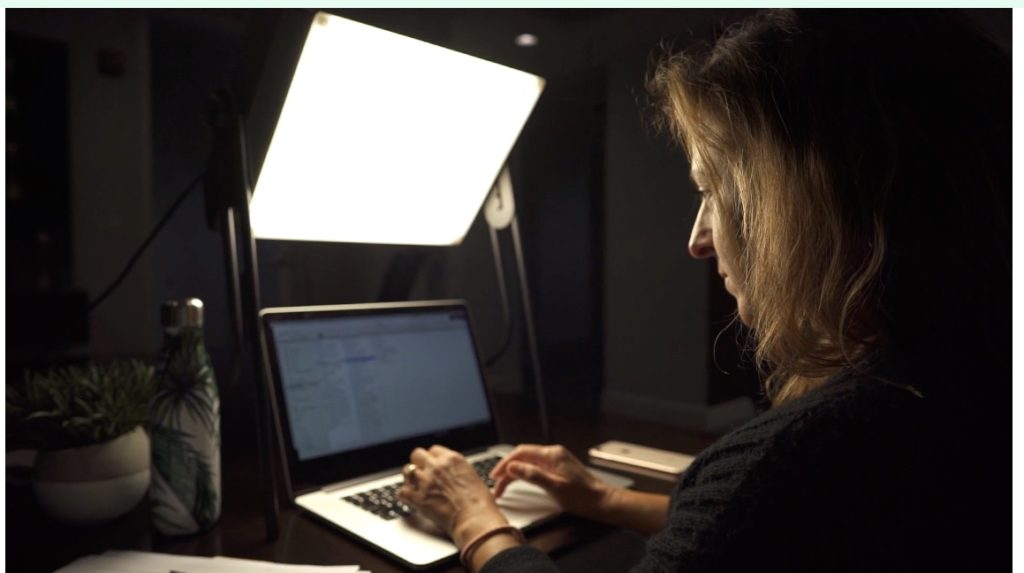Photo courtesy of Michael Terman, PhD
Seasonal Affective Disorder (SAD) affects millions of Americans, but hopping into a tanning bed won’t help. Here’s why visible light therapy is a safer, more effective way to ease symptoms.
The winter season can bring joy to many people each year — it’s time for holiday decorations, winter sports and cozy nights with hot cocoa by the fireplace. Unfortunately, many other people often find winter dark, cold and depressing, and consider the months between November and April a time to be endured rather than enjoyed. If the winter is very much not a wonderland for you, it’s possible you’re one of the up to 10 million people in the U.S. who is suffering from Seasonal Affective Disorder (SAD).
Wintertime Blues
SAD is a condition that can trigger depression that reappears every year, usually in the winter, with relief in the late spring and summer. “SAD can destroy your ability to work, meet family obligations and engage socially,” says Michael Terman, PhD, president of the nonprofit Center for Environmental Therapeutics. “SAD-related depression is usually also accompanied by physical symptoms: difficulty waking up, sleeping longer hours, craving carbohydrate-rich foods and gaining weight that is easily lost in late spring.”
If your symptoms are associated with wintertime, it’s logical to think that traveling somewhere warm to soak up the sun or — a more accessible option during colder months — using a tanning bed could be the solution. The instinct isn’t completely incorrect, as light can play an important role in the treatment of SAD. But it’s visible light that is the key, not ultraviolet (UV) light, the dangerous radiation emitted by tanning beds.
“If you see a salon advertising UV tanning as a cure for SAD, don’t believe it,” says Dr. Terman. “UV radiation (UVR) stimulates the body to produce endorphins, chemicals that produce temporary feelings of calm and well-being. These time limited ‘highs’ undoubtedly influence tanning’s popularity among women with SAD. However, it is not the solution; bona fide light therapy works through the eyes, not through the skin.”
UV radiation is not an effective treatment for SAD. It can lead to premature skin aging and, worst of all, exposure is a serious risk factor for skin cancer. So, for those who want to keep their skin healthy and get relief from SAD, what’s the answer? Visible light therapy, which is generally provided by a light box.
A Synthetic Sunrise
Visible light therapy is often effective because of the way SAD affects the body’s sleep cycle. Normally, the body’s level of melatonin (a hormone that helps control when we sleep) is highest at night and lower in the morning. People with SAD often experience higher-than-normal levels of melatonin in the morning, however, causing them to sleep later or experience fatigue. The brain relies on morning sunlight to help keep our internal clock in sync, but the late sunrises of winter deny our bodies this important signal. Depression can result from waking up for the day while it’s still dark outside.
“SAD is more frequent in the northern half of the U.S., where winter sunrise is significantly later than in the south,” says Dr. Terman. “It is also more common toward the western edge of time zones — sunrise is about an hour earlier on the eastern edges.”
A light box can provide a springlike sunrise signal that aids the brain in keeping our internal clock synced up to the actual time — even when dreary winter days aren’t cooperating. Ordinary indoor lighting is about 50 to 300 lux (a unit of measurement of the amount of light reaching the eyes). This level is about the equivalent of twilight, while a light box with 10,000 lux of illumination provides a truer outdoor daylight level. If you sit at a light box (usually for 30 minutes after waking up) even your most disruptive clinical symptoms can clear up quite quickly, sometimes within days.
Choosing the Right Light
There are many light boxes available in stores and online, but Dr. Terman says that few have been clinically tested, and it’s best to follow certain guidelines when deciding which product is best for you.
“The light box should have been tested successfully in peer-reviewed, placebo-controlled clinical trials, and should be able to provide 10,000 lux illumination,” he says. “It should also have a smooth diffusing screen that filters out the small amount of UVR emitted by the bulbs used.” Many today use LED rather than fluorescent light, but these tend to be too small to reach effective lux levels at the eyes, and convincing clinical trials are still lacking.
Dr. Terman also recommends choosing a box that projects light downward toward the eyes to minimize glare. Finally, the lamp should ideally give off soft white light, as full spectrum and blue light can cause glare and may harm the retina over the long term.
For some, it can be difficult to resist the temptation of a warm tanning bed during the doldrums of winter. Considering the sizable risks associated with UV tanning and its ineffectiveness for treating SAD, though, it’s better to reject the tanning option. Visible light therapy, combined with a healthy lifestyle of exercise and a nutritious diet, is the way to combat seasonal depression.
The Seasonal Affective Disorder information on this page has been adapted from an article written for The Skin Cancer Foundation Journal by Michael Terman, PhD.





